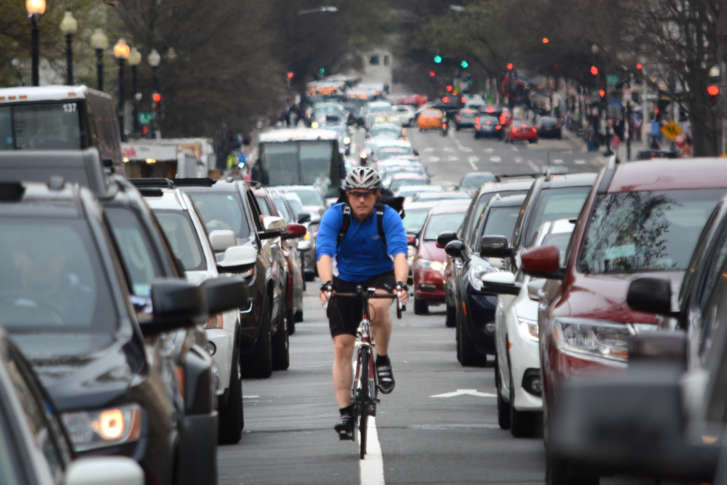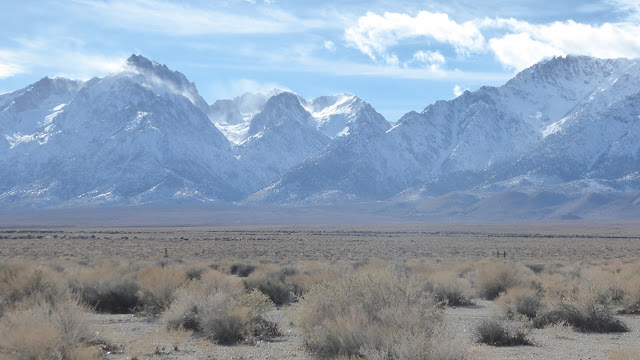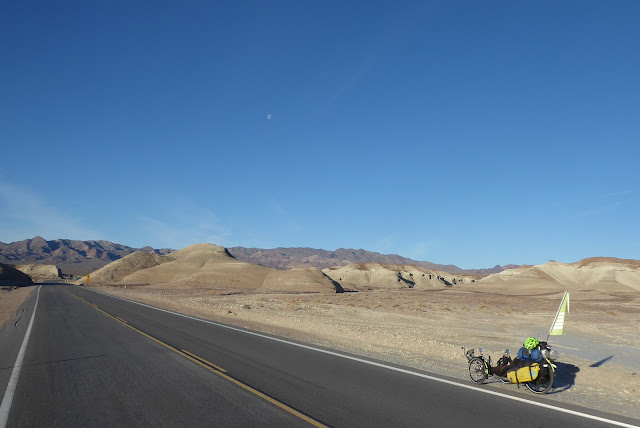
Okay, to the photo above is a joke--in terms of cycling but not, of course, to the poor souls rotting in their tin cans. On this tour, I encountered a wide variety of conditions, and I wanted to recap and detail what I encountered for those who may want to follow in my wake.
First of all. DON'T DO IT. At least the exact route I took. Let me explain. Most of the tour was good, often excellent riding, but about 20% should for sane people be a no-go-zone for cycling. Here are the different sections and what to expect.
Hwy 395: From about Ridgecrest in south almost to Bridgeport in the north, 395 offers double excellent cycling--often divided, double lanes, fat, fat smooth shoulders. One section north of Bishop was chip sealed some time ago, but most of the rest is wonderful. Traffic is moderate to light. Full services in Bishop, including bike shops. The other little towns offer a lot, too.
Death Valley: This is world class, do-it-before-you-die road riding. All the major routes have good to excellent pavement, and the only commercial trucks are smaller ones there to service the few concessions in the park. The main considerations, if you have the flexibility, is to avoid peak visitation periods. Avoid Christmas to New Years and any long holiday weekends during the cool months. Spring seems to be more popular than fall. I've pedaled through during a cool spell in March, but mostly I've toured in mid-winter. Personally, I wouldn't want to ride there when temps get in the 80's, but, of course, each rider must choose her own conditions. For me, the no-go months are generally April through October, but obsessive weather site study can reveal windows when the riding can be good. On a long tour such as this one, Death Valley is only one of several warm/hot zones, so going at the right time of year is critical. The store at Stovepipe has minimal supplies--but you can get some brews. Restaurant and lodging are available for those who don't want to camp. Furnace Creek has a better store. Texas Spring is the camp you want--no generators allowed.
Death Valley Junction to Baker: More great riding here, but there are some important considerations. The ride from DVJ south to Baker is good riding, but traffic once again becomes an issue. Although not extreme, truck traffic makes an appearance. The road has no shoulder, and the volume of traffic seems to have increased since my last tour through the area. Riding it early in the day could help. If you blast through from Furnace Creek, this won't be possible, however. You can stay at the Amargosa Hotel or camp in that area. You'll want to camp at the RV park in Shoshone for sure, which is the last supply point before the dry run to Baker on Hwy 15, about 60 miles south.
Critical issue! Ride the stretch from Shoshone to Baker ONLY Monday through Thursday, and possibly avoid those two days depending on the timing of any long, holiday weekends. You will ride by the Dumont Dunes off-road recreation area, which sees extreme traffic on weekends and holidays, vast streams of RV's, campers, huge trucks with "toy" haulers, etc. Under no circumstances do you want to deal with those people on top of whatever truck traffic might be using the road. On several tours, we've hauled our dog with us, so that meant camping in the vicinity of the Amargosa Hotel and again about half-way between Shoshone and Baker. These camps necessitated hauling water. Most cyclists will have no problem avoiding these camps. Baker has a crappy market and a stack of convenience stores. The best supply store is the Mexican market next to The Mad Greek restaurant, the best place to eat. You can get tasty gyros and salads. We've stayed once in a motel there--NOT great. Ever since, we've loaded up with water and pedaled a few miles into the East Mojave Preserve to throw down for the night. This is a great option. I suppose I might stay in Baker again if there were some sort of extreme wind event.
The East Mojave Preserve: As the blog describes, the "pavement" here used to provide the tortures of the damned, but it has since been "up-graded" to serviceable chip seal. I don't know how many years this will last, and cracks and potholes are already beginning to show, but it's okay for now. Leaving Baker, you'll have water ONLY at Kelso until you get to Fenner way out on Hwy 40. Our strategy has been to crank from Baker over the long pass, drop down to Kelso, water up, crank a bit south and camp off a dirt road on the climb to Granite Pass. You'll find the road about 5 miles south of Kelso, give or take. This is spectacular riding, but, alas, I've got some bad news. On weekends, thanks, I'm sure to the glories of Google maps, traffic will appear starting in Kelso. Drivers coming from the south, off Hwy 40, are now using these once virtually empty roads as a shortcut to get to effin' Vegas. The stretch from Baker to Kelso was basically deserted, but once I hit the intersection at Kelso, the cars just kept coming. Amazing. I dropped in on a Friday, so the bulk of the traffic was south to north. I left the area on a Sat., and traffic was lighter but still present. I suspect that climbing out of Kelso on a Sunday might be unpleasant. So, once again, I suggest careful timing for the best riding conditions. Plan layovers and rest days, if possible, to be riding through the East Mojave between Monday and Thursday. If you ride Shoshone to Baker on a Monday or Tuesday, that should do the trick.
Hwy 40 to Needles: Once you crack Granite Pass--spectacular!--you get a nice drop to Hwy 40, although if you are continuing south to 29 Palms, the drop is truly staggering. For this tour, I was headed east, so Interstate 40 it was. The riding, however, was excellent--with the qualification of the traffic noise. The shoulder is wide, very smooth, and fast. Bring good earplugs to deaden the sound, and you'll be happier. Cyclists can camp for free and get brews/convenience store food at Fenner. I got back on I 40 in the morning for the run to Needles and was directed to leave the highway at Goffs Road. While this will take you back to Rt. 66 and seemingly good riding, it requires you to get on Rt. 95 to drop back to I 40. As I've explained before and will again Rt. 95 SUCKS! Huge fast traffic, no shoulder. Don't do it. Stay on I 40 for a couple of mild climbs then a many mile sweet roll into Needles, a crusty desert town but with all the usual amenities. The Motel 6 is cheap and clean.
Needles to Lake Havasu City: A quick study of the maps will show you a good way to get over to Rt. 1, a "scenic" road that, alas, has more traffic than I remember. Rolling climbs, chip seal, good views but compromised due to traffic. You'll land on Golden Shores and quickly pick up Hwy 40 again. About the first mile, give or take, on I 40 will leave you wanting to quit the tour, but the shoulder does improve substantially. The run from I 40 to Lake Havasu has a rough shoulder to start with, but after you top a long mild grade, the descent to the town is GREAT! Big, big fun. As I describe in the narrative, jump on the multi-use path as soon as you see it. You won't be sorry. ALL services available, including bike shops. Wild BLM camping available in SARA park, just across from the end of the bike path--climbing all the way out of town.
Lake Havasu City/SARA Park to I 10 cutoff/Hope: This is the world of suck part of the tour that will keep me from ever riding this route again. Fifteen years of development and population growth and a corresponding lack of ANY road improvements means that you should avoid this section. It just flat-out sucks, and I see nothing on the horizon to improve it. Now, one option--not a bad one--would be to rent a U-Haul and simply motor this stretch. There is a neighborhood U-Haul dealer in Salome, which is on Rt. 60, after the road improves.
Hope to Prescott: While the riding from Salome to Congress is boring, the traffic is generally quite light, and there is a decently wide shoulder. It's pretty rough, but I found that I could usually ride in the lane and bob over as traffic approached. Congress to Prescott is some of the best riding of the tour--simply spectacular. It's a big day, however, so be ready for a fight, 4,600+ feet of elevation gain.
Alternate Route: For those who'd like to pedal all the way, the best option would be to pick up Rt. 66 east of Needles and climb through Oatman to Kingman and take the Mother Road all the way, basically, to Ashfork and Hwy. 89. This would be a great option. You miss the Sonoran Desert, but the riding works for us cycle touring folk. A couple of considerations: One, you will be above 4,000 to 5,000 feet for a few days, so timing is critical. Mid-winter CAN be okay, but a big storm could ruin your tour. Pick a good weather window (cold nights/mornings!) or go in a slightly warmer period, say November or March. I've ridden this section east-to-west in 2007, and it's pretty good. Traffic becomes and issue as you head south on 89 towards Prescott, although there will be a shoulder most of the way or double lanes when there isn't. From about Chino Valley south, commuter traffic appears in the mornings/evenings.
Overall, this is remote riding, so be confident in your gear and ability to effect road-side repairs. I would consider this somewhat advanced-level touring. It's not outer Mongolia, but it is about as remote as one can get on paved roads in the USA. Ride accordingly.




































